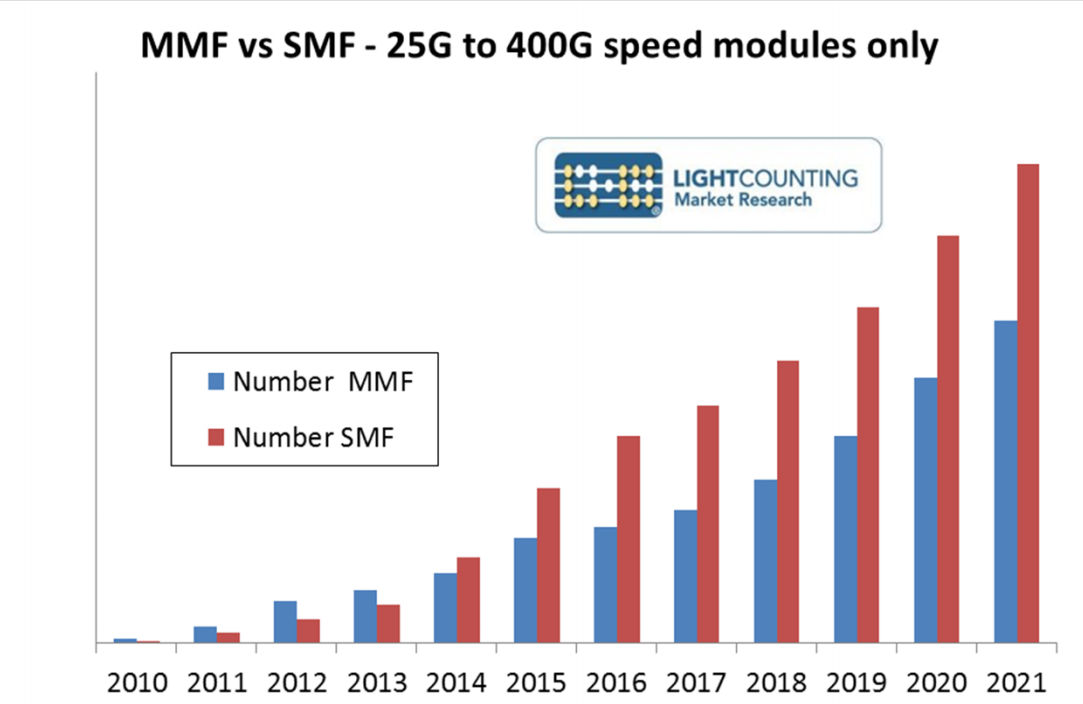Multimode fibre has long been the mainstay of data centre networks due to its ability to provide an economical system for high-speed connections between servers, switches and storage.
Multimode fibre is known for the host of benefits it offers the data centre market – and beyond. For example, if it has a larger core size than single-mode fibre, it can guide multiple modes and more easily capture light from a transceiver. This means it can decrease alignment costs and, while the cost of multi-mode fibre itself is arguably higher, cost savings are made in the long run due to the lower cost connectivity, installation, lower power consumption and ongoing maintenance and usability.
In today’s market, however, where higher data rates are the holy grail – it is predicted when 5G is finally released, it will increase bandwidth twenty-fold – there have been discussions surrounding whether multimode fibre will be able to cope. These have included speculation as to whether the largest hyperscale data centres are expected to adopt only single-mode fibre going forward.
Not so fast
But should the industry be hasty in its rush to migrate? John Kamino, product manager, and Mabud Choudhury, standards manager at OFS Optics, do not necessarily think so. Kamino explained: ‘In general we’ve seen a lot of discussion about the direction that data centres are taking and people are asking whether there are any technological advantages remaining for multimode fibre. We believe that multimode technology continues to evolve and is able to support higher speeds. It’s still the most economic choice for many short reach applications in the data centre.’
Choudhury agreed: ‘The data centre market is growing, particularly in the cloud space. With cloud computing there’s an assumption that, the largest providers are pushing the higher data rates and longer reach, and tending to use single mode. Some of those assumptions have valid points, but it is incorrect to say that all hyperscale cloud providers only use single-mode when many still use multimode. On-premises data centres, hybrid cloud implementations, multi-tenant data centres, and some of the largest hyperscale cloud companies are still using multimode. Even as data rates keep going up, there is still relevance to multimode for low power, short reach applications. People have a misconception that everything service provider- or cloud-based is going to be single-mode only.’
One of the reasons for this is multimode’s ability to be used with cheaper transmitters based on vertical-cavity surface-emitting lasers (VCSELs), which reduces the overall cost of the system. VCSELs bring their own advantages to the table, thanks to their ease of manufacturability and integration, as well as reliability, testability and power efficiency.
Cost effective
Kamino explained: ‘VCSELs have always been one of the primary reasons that multimode solutions are cost-efficient. They are lower cost, easier to make, and have lower power consumption, providing key advantages for multimode solutions.’
Added Choudhury: ‘A lot of companies have expertise in the VCSEL area. In the past, when data centre reaches were limited to 100m and data rates were lower, the VCSEL multimode link was dominant. There is no doubt that single-mode solutions are growing rapidly with higher rates and longer reaches, however, for switch-to-server/accelerator links or shorter switch-switch links, even as rates move to 100Gb/s per lane, there is still a significant future for VCSEL-based multimode links as a low-cost, low-power, high density solution. These links are still the most robust in terms of resilience to dirt, another advantage in the operating environment.’
These are just some of the reasons to suggest that multimode is still very relevant, and will remain so for a number of years, driven by the latest standards, technology and market trends.

As an example, the Ethernet market, which continues to grow, widely uses multimode/ VCSEL-based optics for structured cabling and point-to-point short-reach links. Meanwhile, more than 90 per cent of Fibre Channel link use this combination, according to data from analyst firm Dell’Oro, and this is predicted to continue to be a major application. In fact, a recent forecast from LightCounting predicts continued strong growth for 25G to 400G multimode optical modules from 2019 to 2024.
Returning to the data centre market, Kamino and Choudhury firmly believe this will continue to have a strong demand for short-reach, cost-effective multimode solutions. The off-premises colocation, close-to-end customer fog and edge data centres, as well as telecom-central office data centres could provide new markets for short reach <100m/150m OM3/OM4/OM5-VCSEL links, as these needs are supported by new application standards from IEEE 802.3 and T11 Fibre Channel, along with MSA and multivendor proprietary solutions.


